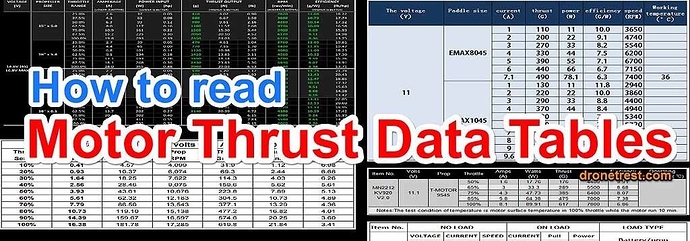In this guide I will discuss how you go about finding and using the motor thrust performance charts to help you to find the best motor for your drone. If you want to learn more please see our guide on choosing the best motor for your drone.
What is a thrust data table
Also refereed to as a motor performance data table. But essentially its a table that shows us all the performance data of a motor. During the production of a brushless motor, the manufacturer will run a series of tests at various operating conditions to assess the performance of the motor. THis information is recorded onto a table for us to look at to compare the performance of various motors. It is also used to help us know what ESC and propeller to use with a motor.
What does a thrust data table tell us?
Depending on the manufacturer the layout and column headings might be slightly different, however fundamentally they all include the same information as discussed in this section.
One thing to note is that the thrust data tables are calculated in static conditions, so in reality the performance of your motor might be slightly different than what it says in the table
Voltage
This column shows the voltage for each test point. This also lets you see the effect of voltage on the performance of the motor.
Propeller Size
This is the propeller size in terms of diameter and pitch. You can use this column to see what propeller you should use with your drone based on the thrust and efficiency each propeller produces.
Throttle
This column shows the throttle percent that is applied to the motor.
Amps (Current Draw)
The Amps column shows the amount of current the motor is using to produce a given amount of thrust. This column is used to see what size ESC you need. You use the current draw at max throttle to see what size ESC you need. Also you will see that depending on what size battery or propeller you use will have an effect on the ESC you need.
Thrust
This column shows ow much thrust the motor can product, usually in grams. You use this column to see if the motor is powerful enough to lift your quadcopter.
Watts (Power)
This column show us the power of the motor.
Efficiency (g/W)
This column is particularly useful when choosing a motor as it lets you know how good it is. The more efficient a motor, the longer you can fly for. The efficiency for motors is worked out by dividing the thrust by the power. The higher this number, the more efficient your motor is. You will often find that larger motors with lower kV ratings have much better efficiencies than the smaller, high kV motors.
RPM (Revolutions per Minute)
This column shows you how fast the motor is spinning.
Temperature
This column shows how hot the motor gets during a certain period of running.
How to choose the best motor for your drone.
Now that you have a better idea on how to read and use motor thrust tables, you should read out guide on how to choose the best motor for your drone which guides you through the factors you need to consider when buying a brushless motor.
The motor does not include a thrust data table
Unfortunately not all manufacturers or internet shops publish the thrust data tables. This often makes it much harder to see if the motor will be suitable for our application. However if required you can often ask the shop for the data and they should be able to provide it to you. Otherwise you can always create your own using a DIY motor test rig.
Building your own thrust data test rig
This video shows you how to go about measuring your motor performance data yourself by building a custom motor test stand. There are hundreds of designs on the internet, including some kits that you can purchase to test your own motors. But all you need is a scale to measure thrust, and a watt meter to record the motor current flow, power and voltage.
If you have any questions just ask them below!

